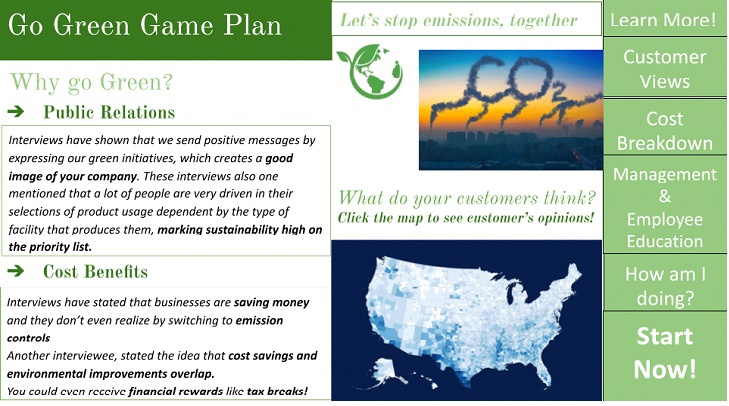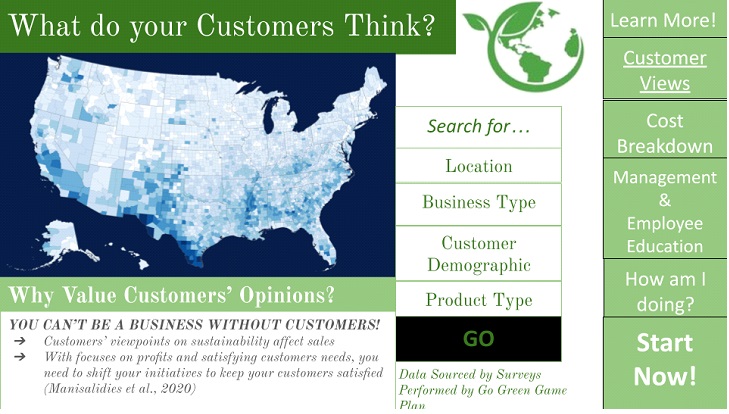By Alysse Dinoff and Dr. Eli Typhina
Despite air pollution in North Carolina’s Research Triangle reaching a historic low, businesses can do more to reduce harmful, fine particle pollution that can lead to problems like heart disease, asthma, and low birthweight (Particle Pollution and Health).
My name is Alysse Dinoff, I am a senior majoring in Environmental Sciences and I decided to find ways to help businesses further reduce air pollution for my ES 495, Environmental Behavior Change course project with Dr. Eli Typhina. My goal, develop a technology that could increase the number of large Raleigh businesses that implement emission controls, tracking, reporting, and reduction targets to improve local air quality. I chose this goal because of my interests in air pollution and working with businesses. One business that inspired my project was GreenPlaces – who urge businesses to reduce their emissions through education on how and what to expect in the future by explaining market volatility, shifts in investing trends, and shifts in consumer behaviors (Green Places, Inc., 2023).
Drawing from Behavioral Theories
Since my project focused on increasing emission controls, tracking, reporting, and reduction, I chose to study the problem through the behavioral concept of worldviews. Worldviews consist of a combination of an individual’s beliefs, values, and attitudes that help them filter information, understand activities, and dictate expectations (Jurin, Roush, & Danter, 2010). With this perspective, one can see customers’ worldviews, focused on sustainability and ecologically friendly products, increases customer demand for businesses to become greener, which in turn serves as motivation for companies to go green (Terzini & Hayes, 2023). Furthermore, businesses’ worldviews usually focus on their profits and satisfying their customers’ needs, so with customers’ shifting environmental values businesses must shift their practices to keep customers satisfied (Manisalidis et al., 2020). The four experts I interviewed during class mentioned the similar business motivations, specifically customer-business relationships, reduced costs, and increased profits (as shown by “Public Relations” in the diagram below).
The second behavioral concept I explored for my project was the Diffusion of Innovation Theory. This theory demonstrates how and why some innovations can be adopted quicker and more effectively than others and includes the following 5 stages:
(1) gain knowledge about the innovation,
(2) persuasion to use the innovation,
(3) decision to adopt or reject the innovation,
(4) implementation or use of the innovation,
(5) confirmation, when the innovation is evaluated and a decision to discontinue using or continue using it is made (Klöckner, 2015).
I chose this theory because my interviewees and the 10 literature sources I reviewed mentioned challenges with finding, adopting, and implementing environmental changes in companies. For example, some companies lack awareness of environmental options (Kurland & Zell, 2011), which aligns with the first step in the theory – to gain knowledge about the innovation by educating management. The theory’s second to fifth steps align with trends showing how client demands to go greener serve to persuade adoption and implementation of such practices (stages 2-4), with increased sales – caused by such adoptions -aiding in confirmation to maintain practices (stage 5) (Terzini & Hayes, 2023).
With this knowledge, I explored existing innovations to see how they addressed, or not, company needs when it comes to their worldviews and adoption to innovations. In my search I found Climate TRACE, a global non-profit that enables companies to track and compare greenhouse gas emissions with satellite imagery and other forms of remote sensing, artificial intelligence, and collective data science expertise. I liked how this company made their goals of sustainability clear and had a system of tracking the emissions, so I decided to build on this by creating a prototype that also included information on the harm caused by emissions and how companies can reduce their emissions. To this, I include data tracking customer opinions regarding sustainability and other elements that would connect with customer and company worldviews and stages from the diffusion of innovation theory.
Below, chain of influence diagram demonstrates how behaviors (green) interacting with the government and customers (pink) can influence the ways that large businesses implement emission controls.
Emissions Reduction Prototype
Drawing on my research and theory insights, I decided to design my technology for large industrial facilities and companies that emit large amounts of pollution, such as Biogen, who is already working towards eliminating fossil fuel emissions by 2040. With the insights I gained from understanding businesses worldviews (Jurin, Roush, & Danter, 2010), I created a prototype website (homepage shown below) that caters to company values (e.g. the benefits to profit and public relations), as well as alignment with client values (e.g. sustainability and, ultimately, reduced emissions).
When companies click on the “What do your customers think?” map on the homepage, they land on a page that can increase their motivation to adopt emission reduction measures (image below). Applying step 2 in Klöckner’s (2015) Diffusion of Innovation Theory, seeing customer’s opinions related to sustainability could persuade highly profit oriented businesses to shift their practices to reduce emissions. According to Terzini & Hayes (2023), when customers have increased awareness of environmental issues, they demand more ecological products; furthermore, when these companies sell and use green products and packaging, these measures benefit their sales.
The image below shows the prototype page called “Cost Breakdown.” I created this page because one of my interviewees expressed how some companies have a short term view of goals and costs, making it hard to convince them to look at the bigger picture of why they should implement sustainability standards. Burchardt (2021) confirmed this insight, stating that upfront costs can scare some businesses away, but eventually the costs will even out over time, with the added benefits of green operation. Therefore, the page addresses both long and short term goals and costs of adopting measures to reduce emissions, which enables companies to clearly see how their goals align with environmental measures (Klöckner, C. A., 2015).

The “Management & Employee Education” page focuses on Klöckner’s (2015) Diffusion of Innovation Theory step 1: gain knowledge about the innovation. I focused on this because across my literature and interviewees I found the need to convince companies to engage in sustainability measures through education and investment in a sustainability manager (Kurland & Zell; 2011). Therefore, this page provides information for sustainability managers, education for employees and managers, as well as analysis on the company’s current strategies.
The page below, called “How am I doing compared to…” would allow companies to compare their emissions with other companies around the world, such as looking at competitors’ carbon, nitrogen, and sulfur dioxide emissions. According to Gore (2022), a tracking system, similar to this one, creates a sense of need for change so that businesses remain competitive in the market. Since competition relates directly to monetary success of a business, this knowledge can further persuade companies to action so that they remain in alignment with their worldviews (Jurin, Roush, & Danter, 2010).
Moving Forward
If my proposed prototype were created into a website and company, it would enable businesses to reduce overall emissions, thus improving health, because it offers businesses guidance in adopting sustainability measures (City University London, 2020). By taking this course and creating this prototype, I learned new methods of research and how to create a portfolio of a long term, comprehensive project. With this experience, I would like to continue working with businesses to reduce their emissions, whether managing emissions software, developing recommendations for what can improve, or working with teams to implement new emissions controls. If you are interested in working with me, please connect with me on LinkedIn (image of Alysse Dinoff below).
References
Burchardt, J. (2021, April). How we can curb climate change by spending two percent more on everything. Jens Burchardt: How we can curb climate change by spending two percent more on everything | TED Talk. https://www.ted.com/talks/jens_burchardt_how_we_can_curb_climate_change_by_spending_two_percent_more_on_everything/transcript
City University London. (2020, January 22). Sustainability strategies more successful when managers believe in them. ScienceDaily. Retrieved September 5, 2023 from www.sciencedaily.com/releases/2020/01/200122080517.htm
Gore, A. (2022). Measure emissions to manage emissions. Science, 378(6619), 455–455. https://doi.org/10.1126/science.adf5788
Green Places Inc. (2023, June 23). Our mission. GreenPlaces. https://greenplaces.com/our-mission/
Jurin, R. R., Roush, D., & Danter, K. J. (2010). Environmental communication: Skills and principles for natural resource managers, scientists, and engineers. New York, NY: Springer.
Klöckner, C. A. (2015). The psychology of pro-environmental communication: Beyond standard information strategies (pp. 103-118). London, UK: Palgrave Macmillan.
Kurland, N., & Zell, D. (2011). Green Management: Principles and Examples . Organizational Dynamics, 40(2), iii. https://doi.org/10.1016/s0090-2616(11)00026-x
Manisalidis, I., Stavropoulou, E., Stavropoulos, A., & Bezirtzoglou, E. (2020, January 17). Environmental and health impacts of Air Pollution: A Review. Frontiers. https://www.frontiersin.org/articles/10.3389/fpubh.2020.00014/full?fbclid=IwAR1f2tGC8xhSMzCqeTWl2pnOr7XCXhucW90feHa11jnE8olvrMdbdLNi7cY
Particle Pollution and Health. (n.d.). New York State Health. https://www.health.ny.gov/environmental/indoors/air/pmq_a.htm
Terzini, F., & Hayes, E. (2023). Greenhouse gas emissions tracking: Making it count. The APPEA Journal, 63(2). https://doi.org/10.1071/aj22207






